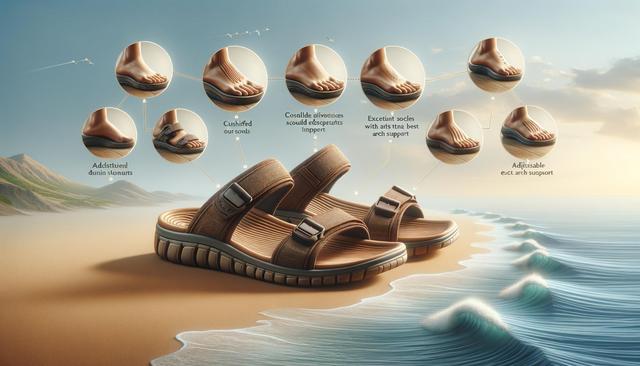Understanding the Importance of Arch Support
Arch support is more than just a comfort feature—it plays a vital role in promoting proper foot alignment, reducing muscle strain, and preventing common foot issues such as plantar fasciitis. The arches of the feet help distribute body weight and absorb shock when walking. Without adequate support, the muscles and ligaments in your feet can become overworked, leading to pain and instability. Sandals, often seen as casual footwear, can lack this essential support. That’s why choosing the right pair with structured arch support is important, especially for those who spend long hours on their feet or suffer from flat feet or high arches.
When shopping for sandals, it’s important to consider how the arch support is integrated into the footbed. Look for designs that mimic the natural contours of your foot. A well-supported arch helps maintain proper posture and reduces impact on pressure points, offering long-term benefits beyond just comfort. Whether you’re walking on the beach or running errands, proper support can make a noticeable difference in how your feet feel at the end of the day.
Key Features to Look For in Supportive Sandals
Not all sandals are created equal when it comes to support. When searching for options that offer exceptional arch support, pay attention to the following features:
- Contoured footbeds that cradle the arch
- Firm yet cushioned midsoles for stability
- Adjustable straps for a secure fit
- Deep heel cups to help align the foot
- Non-slip outsoles for added traction
These features work together to provide a supportive base that helps maintain the natural shape of your foot. Materials also play a role—leather, cork, and high-quality EVA foam are often used in better-quality sandals due to their ability to mold to your feet over time. This personalized fit enhances the support offered, further improving foot comfort and function.
Don’t overlook the importance of fit. Even a sandal with excellent arch support can cause discomfort if it’s too loose or too tight. Try on multiple sizes and walk around in them to ensure they offer both comfort and functionality.
Types of Sandals That Offer Superior Arch Support
Certain types of sandals are more likely to offer the structural support needed for healthy foot mechanics. Understanding these types can help narrow down your options:
- Orthopedic sandals: Designed specifically for foot health, these often include advanced arch support and cushioning.
- Sport sandals: Built for active wear, these offer sturdy soles and adjustable straps for enhanced support.
- Slide sandals with molded footbeds: While minimalist, they can provide solid arch support if designed with anatomical shaping.
- Slingbacks and ankle-strap sandals: These provide additional stability while incorporating supportive footbeds.
Each of these styles brings its own advantages. Orthopedic and sport sandals are particularly suitable for those with chronic foot pain or high activity levels. Meanwhile, casual styles with built-in support can be a good option for everyday use, especially during warmer months.
Evaluate what kind of activities you’ll be doing in your sandals. For example, if you’re planning on long walks or sightseeing trips, a sport or orthopedic sandal may serve you better than a fashionable flat style.
Common Mistakes to Avoid When Choosing Sandals
While searching for sandals with good arch support, it’s easy to make a few common mistakes. Being aware of them can save you from future discomfort and injury.
- Choosing fashion over function: While stylish sandals may look appealing, they often lack the structure needed for proper arch support.
- Ignoring your foot type: People with flat feet, high arches, or pronation issues have different support needs. Choose sandals that cater to your specific foot shape.
- Not testing the fit thoroughly: Always try sandals on both feet and walk around to assess comfort and support.
- Overlooking durability: Supportive sandals should be made from materials that withstand wear and tear. Lightweight foam may feel comfortable but can wear out quickly.
Another mistake is assuming that price always equals quality. While higher-priced sandals often use better materials and design, it’s essential to read reviews and try them personally to ensure they meet your needs. Functionality should always take priority over appearance when it comes to foot health.
Tips for Maintaining Sandals with Arch Support
Once you’ve invested in a pair of supportive sandals, proper care can extend their life and maintain their performance. Here are some maintenance tips to keep in mind:
- Clean them regularly to prevent buildup of dirt and sweat, especially in footbeds and straps.
- Check for signs of wear, especially in the arch and heel areas. Replace them if the support begins to deteriorate.
- Store them in a dry, cool place away from direct sunlight to prevent material degradation.
- Use insoles or orthotic inserts, if needed, to enhance or prolong support.
Additionally, rotate your footwear. Even supportive sandals benefit from being given a break. Alternating between pairs allows the material to recover and reduces the risk of overuse injuries. If you’re using your sandals for daily walking, consider owning more than one pair to distribute wear evenly.
Remember, taking care of your sandals means taking care of your feet. Regular maintenance helps ensure that the arch support remains effective, providing you with lasting comfort and better foot health.
Conclusion: Prioritizing Comfort and Foot Health
Choosing sandals with reliable arch support is a decision that can significantly impact your day-to-day comfort and long-term foot health. By understanding your foot needs and carefully evaluating sandal design, you can find options that combine support, comfort, and style. Whether for casual outings or extended wear, supportive sandals can help reduce fatigue, prevent pain, and promote better posture. Invest in features that matter, and your feet will thank you with every step.


